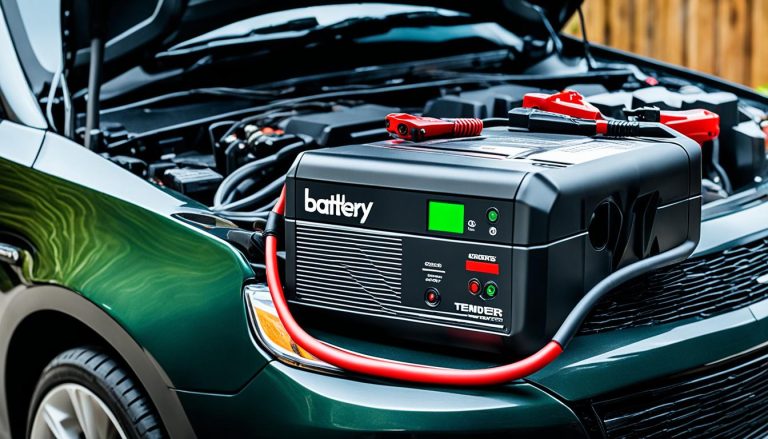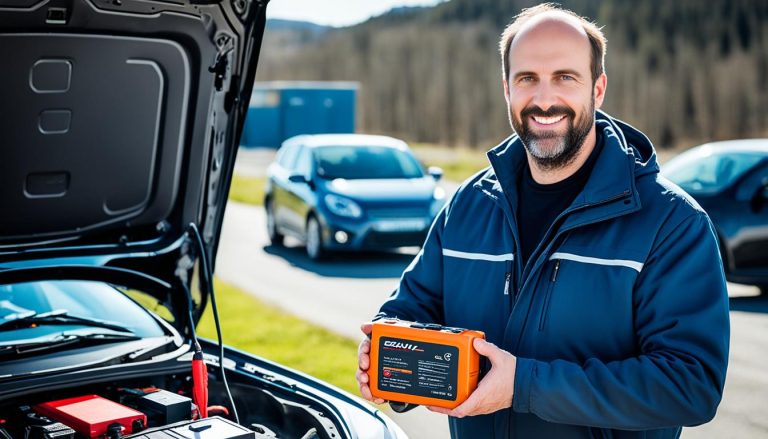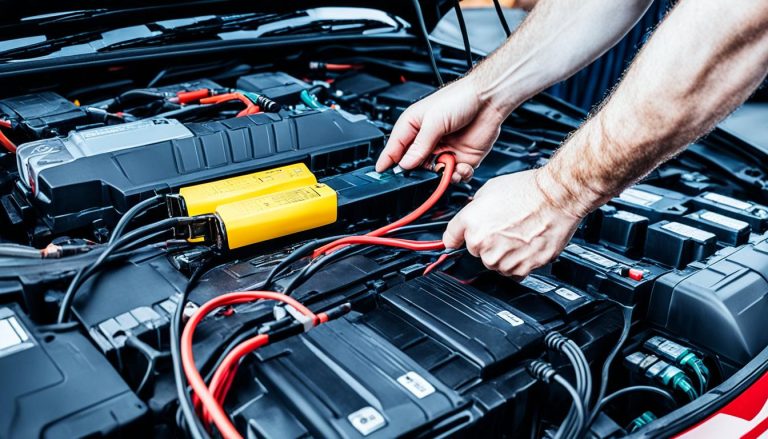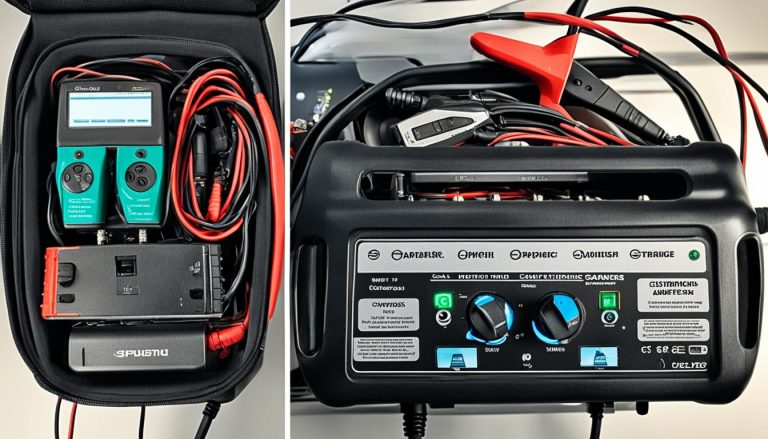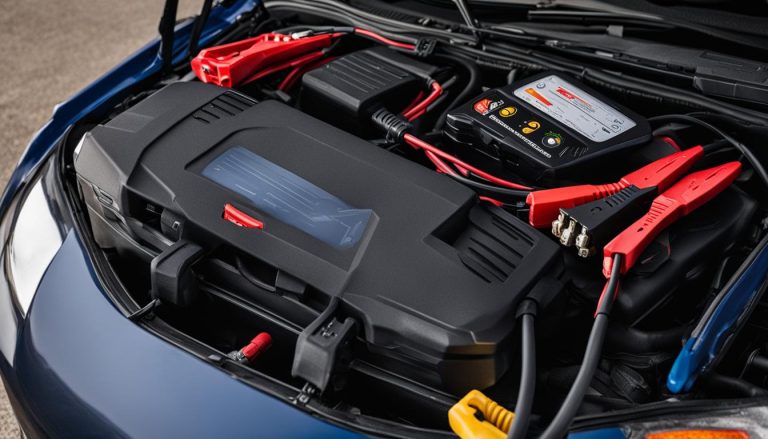Jump Start a Dead Battery Without Cables Guide
batterychargers.site and its partners may earn a commission if you purchase a product through one of our links
Ever been stuck with a dead car battery and no cables in sight? You’re not alone. It’s a common predicament that catches many drivers off guard. But don’t worry; there’s more than one way to revive your vehicle. With the right know-how, you can jump start a dead battery without cables and get back on the road in no time. Whether you’re facing a deserted parking lot scenario or simply prefer to be self-reliant, understanding how to jump start a dead battery without cables is an invaluable skill. You might be surprised at how manageable getting a car battery jump start without cables can be when you’re equipped with alternative solutions and a bit of ingenuity.
Key Takeaways
- Manual transmission vehicles can be started with a push and a clutch pop.
- Portable jump-starters are a convenient solution for automatic vehicles.
- Ensure your safety and the car’s readiness before attempting any jump-start methods.
- Familiarize yourself with your car’s transmission type for the correct technique.
- Regular battery maintenance can prevent unexpected dead battery situations.
- Unconventional methods may exist, but always consider the risks involved.
Understanding the Basics of a Dead Battery
Unanticipated issues with your car battery can leave you stranded and questioning what went wrong. It’s crucial to understand the fundamentals that may lead to a battery losing its charge and how to handle the situation if jumper cables aren’t available. Acknowledging these basics ensures you’re equipped with the knowledge for starting a dead battery without cables.
Common Causes for Battery Draining
The gradual decline of a car battery isn’t uncommon, but there are a variety of factors that can expedite this process. Simple mistakes, like leaving the headlights on overnight, or prolonged exposure to extreme cold, can significantly deplete your battery’s life. When the charge diminishes, the battery is unable to start your car, which can leave you needing to jump start a car without jumper cables.
Signs that Indicate a Dead Battery
Several warning signs may alert you to a failing battery. You might notice that the engine cranks slowly or that electrical components are functioning erratically. These are telltale signs that your battery may soon be dead, and you’ll need to consider starting a dead car battery without jumper cables as an alternative method.
Why Traditional Jump-Starting Might Not Be an Option
There may be instances where traditional jump-starting isn’t feasible. Perhaps you’re in a hard-to-reach area or lack the presence of a second vehicle. In these cases, exploring ways to revive a dead battery without external assistance becomes more than a mere convenience—it could be your only resolution.
In today’s automobile landscape, it’s becoming increasingly important to be self-sufficient. Let’s delve into some specific causes and solutions associated with a dead battery, equipping you with the indispensable skills to handle such a challenge with confidence and ease.
| Cause of Battery Drain | Preventative Measures | Alternatives When Cables Are Unavailable |
|---|---|---|
| Left Headlights On | Automatic Headlight Shut Off Feature | Use a Handheld Jump Starter |
| Old Battery | Regular Battery Testing | Push Starting (Manual Transmission) |
| Cold Weather | Keeping Battery Warm with Insulation | Portable Battery Charger |
| Corroded Battery Connections | Clean Terminals Regularly | Seek Assistance or Contact Roadside Service |
Preparatory Steps Before Attempting to Jump Start
When faced with the need to jump start dead battery without cables, taking certain preparatory steps can make the difference between getting back on the road swiftly and safely, or facing potential hazards. Here, we lay out the essential groundwork for a successful and safe jump start. Remember, preparation is the key to any successful operation, especially when it comes to your vehicle.
Identifying a Safe Environment for Jump Start
The location and environment where you attempt the jump start are crucial. You need a secure area away from traffic and on level ground to avoid any unwanted movement of the vehicle. It’s vital to ensure there are no flammable liquids or gases in close proximity. The safety of both you and your vehicle should never be compromised.
Gathering Necessary Equipment for a Cable-Free Jump Start
When thinking about battery jump start without cables, having the right tools is half the battle. A quality portable jump-starter is your best ally in this situation. Not only should it have the capacity to start your vehicle’s engine, but it also needs to feature safeguards against overcharging or short-circuiting. Check that the jump-starter is adequately charged and in proper working order before usage. It’s not just about power; it’s about the right power, safely delivered.
- Remove any loose metal objects near the battery to prevent sparks.
- Take off jewelry or loose clothing to avoid accidents.
- Verify the condition of the car’s battery and portable jump starter.
- If manual transmission, arrange for assistance to push the vehicle.
- For automatic vehicles, ensure your portable jump-starter is ready to use.

Now that you’re familiar with the foundational safety considerations and have gathered the necessary equipment for a cable-free jump start, you’re one step closer to reviving your car’s dead battery. Stick to these protocols to ensure the best outcome when jump-starting a car without cables.
How to Jump Start a Dead Battery Without Cables
Realizing your car battery is depleted can catch you off guard, especially when jumper cables are not within reach. Whether your vehicle sports a manual or automatic transmission, learning how to jump start a dead battery without cables is a skill worth knowing. For vehicles with a manual gearbox, the technique commonly known as push-starting or bump-starting could be your ticket to sparking life into your engine.
Manual Transmission Vehicles
- Ensure the ignition is on.
- Engage second gear and hold the clutch down.
- Have one or two helpers push the car to gain momentum (preferably on a flat surface or slight decline).
- When the speed reaches approximately 5 mph, release the clutch to turn over the engine.
- If the engine starts, great! If not, the issue might extend beyond the car battery.
On the other hand, for automatic transmission vehicles, where manual push-starting isn’t applicable, a portable jump-starter is your go-to solution. These devices are simple to use and can jump start your car battery without cables from another vehicle. Ensure your portable jump-starter is fully charged for the best results.
| Step | Action | Notes |
|---|---|---|
| 1 | Charge your jump-starter | Confirm the device’s battery level before use. |
| 2 | Connect the red clamp | Attach it to your car battery’s positive post. |
| 3 | Connect the black clamp | Secure to a non-painted metal surface on the car’s frame for grounding. |
| 4 | Start the vehicle | Turn on the jump-starter and then start your car. If the car doesn’t start immediately, wait a few minutes, allowing the battery to charge slightly, and then try again. |
When facing a dead battery, thoroughness and safety are paramount. Before you start the process, verify that you’re in a secure and appropriate environment and that all devices are in good condition. With the right approach, even without the help of jumper cables, you can revive your car battery and continue on with your travels.
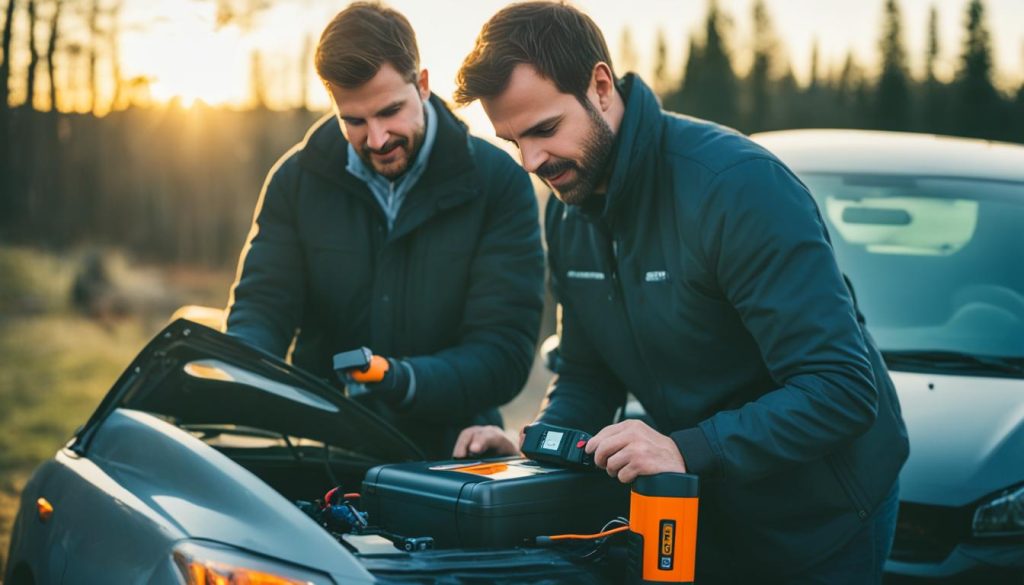
Remember, while these methods are effective, they’re a temporary fix. It’s advisable to drive your car to a service station afterward to ensure your battery doesn’t need replacement and to prevent future issues with your vehicle’s electrical system.
Alternative Methods to Revive Your Dead Battery
If you’ve been left stranded with a dead battery and no cables in sight, fret not—modern technology offers some ingenious solutions. Whether you’re dealing with a car parked in a remote location or simply want to avoid the hassle of traditional jump-start methods, exploring battery jump start without cables alternatives can be a lifesaver.

These methods not only help you get back on the road but also contribute to a more ecologically sound approach to car care. Let’s delve into a couple of these options and see how they stack up.
Using a Portable Jump Starter Box
When it comes to convenience and ease of use, the portable jump-starter box is a front runner. These compact units are powerhouses, capable of jump-starting your car without the need for another vehicle. They’re essentially stand-alone batteries with clamps to connect to your car’s battery, giving it the surge it needs to come back to life. Plus, they usually come with safety features that protect against overcharging and ensure a safe jump every time.
Exploring Solar-Powered Battery Chargers for Long-term Solutions
For those interested in a sustainable and eco-friendly option, solar-powered battery chargers present an enticing solution. These chargers are especially useful for maintaining your battery’s charge over long periods when you won’t be using your car. Even though a full charge via solar power takes longer than conventional methods, the ability to harness the power of the sun wherever you are is both innovative and efficient.
| Feature | Portable Jump-Starter Box | Solar-Powered Battery Charger |
|---|---|---|
| Power Source | Internal Battery | Solar Energy |
| Charging Time | Immediate Jump; Full Recharge Varies | Several Hours to Days (Weather Dependent) |
| Portability | Highly Portable | Portable, Some Models Foldable |
| Usability | Immediate | Preventative; Slow Charge |
| Additional Features | Safety Lights, USB Ports | Eco-Friendly, Low Maintenance |
| Cost | Varies by Brand and Power Capacity | Generally Affordable, No Operating Costs |
Both options provide solid alternatives to traditional cable jump-starts, but each has its own set of advantages. Your choice might depend on immediate needs or long-term preferences. Yet, it’s remarkable how technological advancements have made battery jump start without cables not only possible but also practical and environmentally conscious.
Troubleshooting Post-Jump Start: What to Do Next
Now that you’ve managed to jump start your dead battery without cables, it’s essential to ensure proper follow-up to avoid the same predicament in the future. Driving your vehicle for a good 15 minutes allows the alternator to recharge the battery sufficiently. However, there’s a bit more to consider for long-term battery health. Monitoring the electrical systems and routinely inspecting the battery itself can unearth potential issues that mere recharging won’t fix. Moreover, understanding how to jump start a dead battery without cables is just the beginning; maintaining your car’s battery life is an ongoing process.
Maintenance Tips to Prevent Future Battery Failures
Preventative maintenance is your best defense against battery failures down the road. Incorporate regular checks into your schedule, including ensuring that your battery’s connections are both secure and corrosion-free. It’s also a wise move to have your battery tested professionally to gauge its capacity for holding a charge. If you find starting a dead battery without cables becoming a recurring issue, it may indicate a deeper problem with your vehicle’s charging system that merits closer inspection.
When to Seek Professional Assistance
If you’ve jump started your car and notice that the issue persists, or if the battery fails entirely without warning, professional help may be in order. Mechanics can test more than just the battery; they can diagnose issues with the alternator, starter, or other components of the electrical system, which may be difficult to assess on your own. Additionally, explore options for roadside assistance coverage, as these services can offer quick support for jump start dead battery without cables, especially when you’re in a pinch. Remember, taking the initiative in proper vehicle maintenance and recognizing when to call the experts plays a crucial role in keeping your travels smooth and uninterrupted.
FAQ
What are common causes for a car battery to drain?
Common causes include leaving the headlights or radio on when the engine is off, the natural decline of battery performance in cold weather, and general wear and tear on the battery over time.
How can I tell if my battery is dead?
Signs that indicate a dead battery include the engine not starting, a slow engine crank, dim headlights, and the need to press the gas pedal to start the engine.
Why might I need to jump start a battery without using cables?
There may be situations where you don’t have jumper cables, a second car to provide a jump, or you’re in a remote location without access to roadside assistance. In these instances, knowing alternative methods can be essential.
What safety procedures should I follow before attempting to jump start a dead battery without cables?
Always check the area around the battery for loose metal objects that could cause sparks, remove any jewelry or loose clothing, and ensure the battery and any equipment, like a portable jump-starter, are in good condition and free of damage.
How do I jump start a dead battery in a manual transmission vehicle without cables?
Use the push-start or bump-start method, which involves pushing the car to get it moving, then engaging the clutch at around 5 mph to start the engine.
Can I jump start an automatic car without cables?
Yes, you can use a portable jump-starter. Connect the device’s red clamp to the positive battery post and the black clamp to a grounding point on the car’s frame, then turn on the power and attempt to start the vehicle.
What are some alternative methods to jump start a dead battery without cables?
You can use a portable jump-starter box or a solar-powered battery charger. These alternatives can provide a charge to the battery without needing cables or another vehicle.
What should I do after jump starting my car to ensure it doesn’t happen again?
Drive the car for at least 15 minutes to help charge the battery, inspect the alternator and electrical system for issues, and consider having a professional check your car if necessary. Maintain routine battery checks and clean connections to prevent future battery failures.
When is it advisable to seek professional assistance after a jump start?
If jump starting the car doesn’t work, or if the battery continues to drain after charging, it’s best to seek professional assistance. A mechanic can diagnose potential issues and provide a reliable solution.

